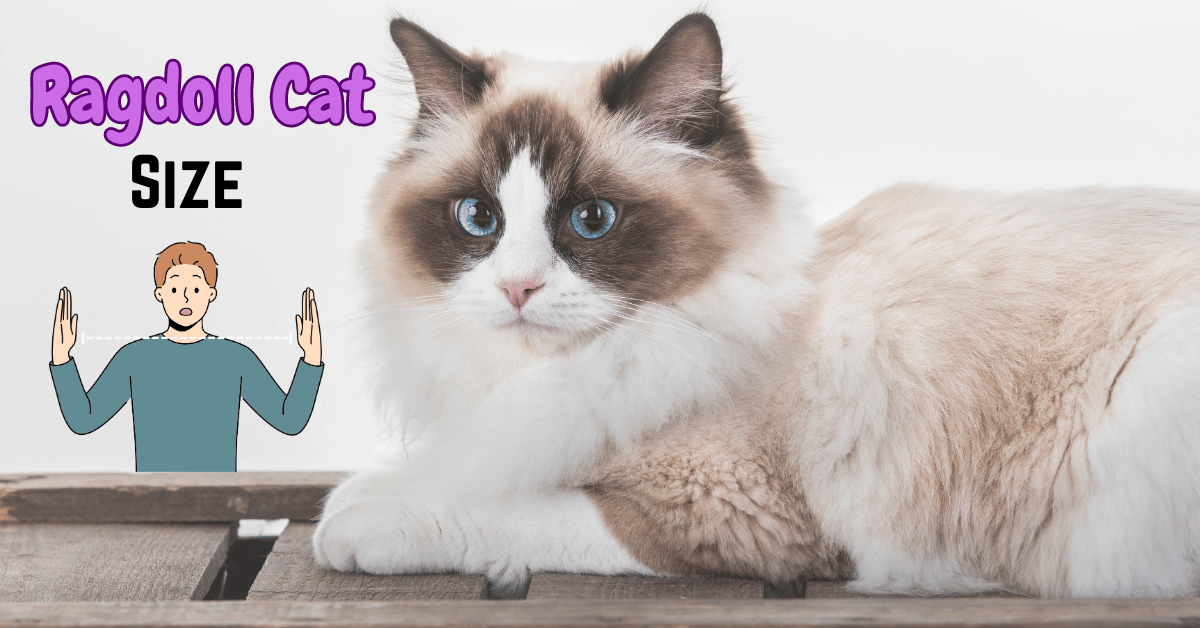This post contains affiliate links and I will be compensated if you make a purchase after clicking on my links.
The Scale of Ragdoll Cat Size
Ragdoll cats, with their serene demeanor and cloud-like fluff, might initially seem just as soft as they look. But don’t let their gentle exterior fool you; although their fluffy mane makes them appear a bit bigger, they are undeniably among the largest felines around.
The creation of the Ragdoll cat focused on selective breeding for their gentle personality traits and their stunning white coat. Interestingly, size wasn’t a major factor in the development of this breed. These gentle giants were not bred to brave harsh conditions or hunt down prey; rather, they were designed to be the perfect cuddle companions.
The paradox between their cuddly nature and robust size is a fascinating aspect of the Ragdoll breed, offering a deep dive into the grand dimensions that define these feline giants.
Growth Trajectory of Ragdoll Cats: Kitten to Colossus
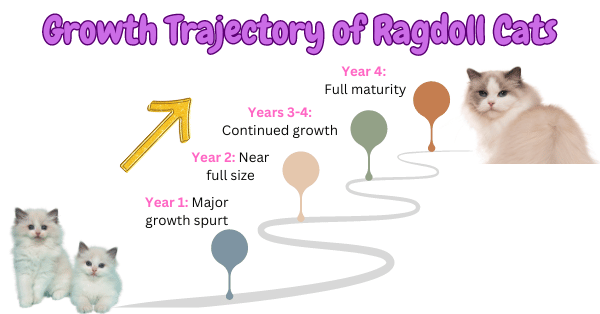
Ragdoll cats truly embody the idea that “slow and steady wins the race.” During the first year, Ragdolls experience the most significant growth spurt. By the end of their second year, they are nearly at their full adult size in terms of height, weight, and body length, yet some continue to fill out and subtly lengthen until they reach the age of four.
This extended growth period is unique among domestic cats, with only a few other breeds like the Maine Coon and Savannah cat rivaling them in size. By the time a Ragdoll cat celebrates its fourth birthday, it should have completely finished growing, standing as a serene and substantial presence within your home.
What Does Size Mean for Ragdolls?
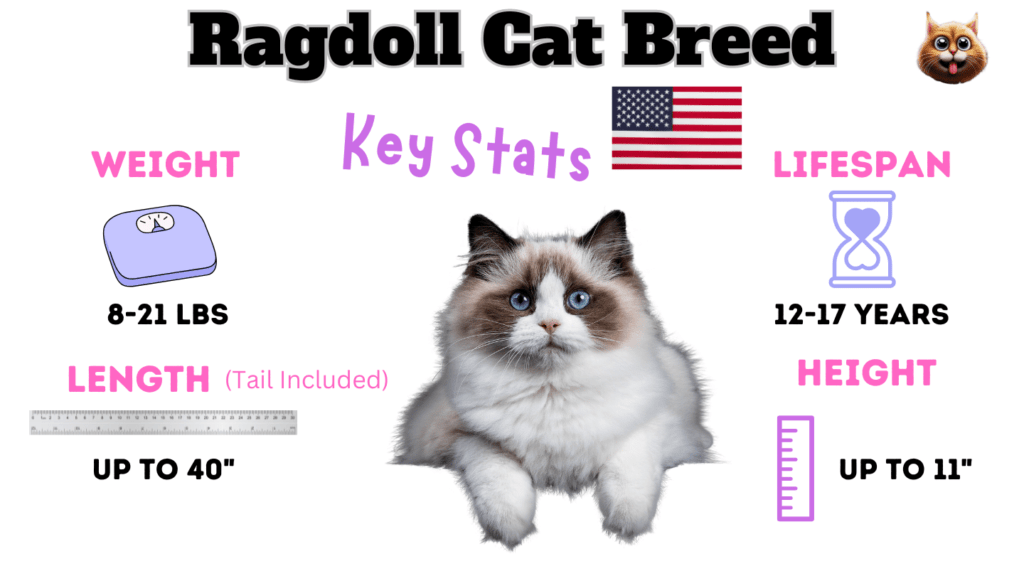
When we talk about the size of a Ragdoll, we’re referring to three key measurements: height, weight, and body length. Here’s a breakdown of the typical Ragdoll dimensions:
- Height: 9-11 inches
- Weight: 8-21 lbs
- Body Length: 17-22 inches
However, if you factor in their luxurious plumed tail, some Ragdolls can stretch out to a whopping 40 inches!
Fact: Female Ragdolls usually show a 15% to 25% reduction in size compared to males, encompassing weight, height, and length.
How Big Are Ragdoll Cats Compared to Other Domestic Breeds?
Imagine a scale with your average house cat on one side and a Ragdoll on the other. This comparative analysis helps highlight just how roomy you’ll need your lap to be if you’re thinking of adopting one of these gentle giants.
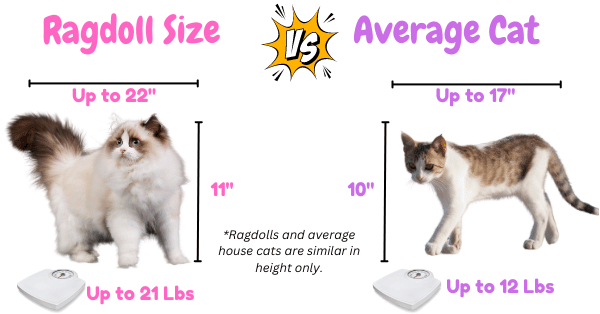
Weight
Ragdolls are substantially heavier than the average domestic cat. They can weigh up to 21 pounds, while most other domestic cats typically range from 7 to 12 pounds. This makes Ragdolls nearly twice as heavy in some cases, highlighting their robust nature.
Height
In terms of height, Ragdolls measure between 9-11 inches at the shoulder. This is comparable to many domestic cats, which usually stand around 10 inches tall. Despite their significant weight, their height is quite standard, which can be deceiving regarding their overall mass.
Length
Ragdolls are particularly long, measuring up to 22 inches from nose to base of the tail, which is considerably longer than most domestic cats. These typically measure between 15-17 inches in length, though some may reach up to 18 inches.
Factors Affecting Ragdoll Cat Size
Ragdoll cats are known for their impressive size, which is influenced by a variety of genetic, nutritional, and environmental factors. Understanding these factors can help owners provide the best care for their gentle giants.
Genetics and Breeding
The substantial size of Ragdolls is largely influenced by genetics, a byproduct of selective breeding that originally focused on traits like a gentle personality and a striking white coat, rather than size.
The genetics of their parents play a crucial role in determining their physical characteristics. These cats were specifically designed for companionship, with their large build emerging incidentally as part of the breed’s development over generations.
Nutrition
Proper nutrition during the early months of a Ragdoll’s life is crucial for achieving their potential size. A diet rich in high-quality protein is essential for building a muscular structure rather than merely adding fat. Technological advancements in pet care, such as smart feeders, can precisely manage diet portions, ensuring optimal growth and health.
Environmental Influence
The environment a Ragdoll is raised in is crucial for their physical development, requiring not just space but thoughtful equipment choices. Ensuring there’s ample room for exercise with oversized cat trees and interactive gadgets like laser pointers and automated toys is essential for promoting regular activity, helping maintain a healthy weight, and supporting overall growth.
Additionally, accommodating their larger size with a high-quality, durable litter box enhances their comfort and hygiene, seamlessly integrating function and care in their daily environment.
Impact of Neutering
Neutering can also affect the size of Ragdoll cats, suggesting that earlier neutering might lead to more significant changes in growth and body composition. This is because neutering can influence the timing of growth plate closure, potentially resulting in a taller and longer physique
Maximizing Ragdoll Cat Size: Thriving in the Presence of Gentle Giants
As your Ragdoll grows, it’s crucial to distinguish between healthy weight gain and undesirable bulk. Regular veterinary check-ups and employing body condition scoring systems are essential strategies to monitor their physical condition, ensuring what you’re seeing is muscle, not excess fat.
By fully understanding the specifics of their growth and catering to their unique needs with the right technology and tools, you can ensure your majestic Ragdoll thrives under your care. Whether they’re sprawling across your sofa or standing out among their feline peers, Ragdolls are bound to leave a significant impression—both on your heart and in your home.
Don’t miss our Ragdoll Cat weight calculator to see if your cat’s weight matches the ideal average>>
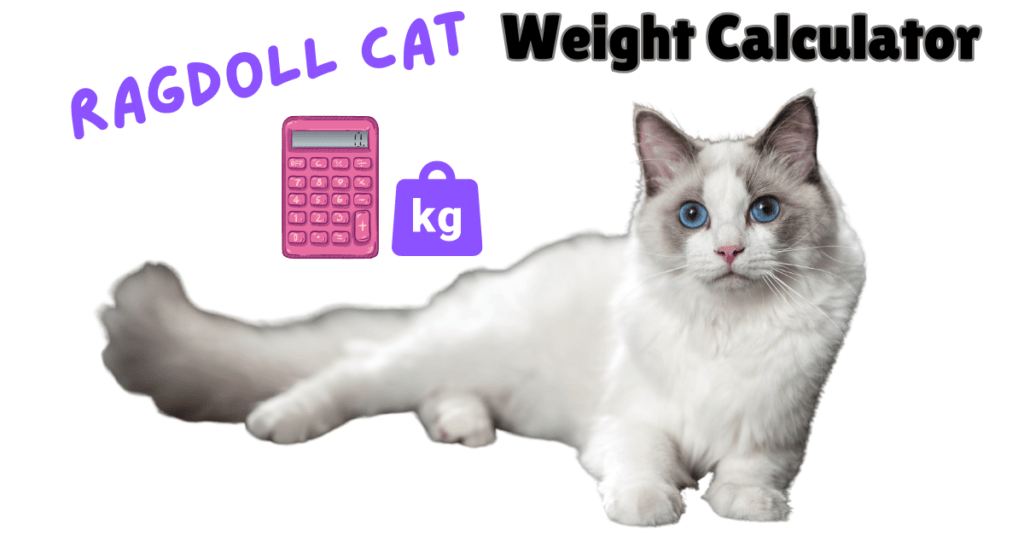
Meet Sean, a fintech whiz with a penchant for pet purrs and blockchain buzz. After a decade of fintech feats, Sean’s tech talents leaped from ledger lines to litter lines, driven by a passion for pets and a vision for a more connected pet care community. With three critter companions as co-pilots, Sean launched this blog to share a treasury of pet-friendly tech tips and tales.

